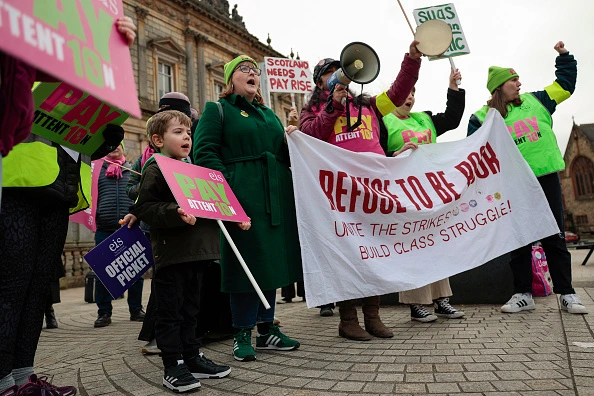
There were 282 different strike actions across the UK in January, up from 196 in December, as the wave of industrial action continues to sweep the country.

In total, the 282 strikes amounted to 121,000 workers, and 220,000 working days lost, a decrease from the month before. In December, UK workers caused a total collective stoppage of 843,000 working days, the highest monthly total since November 2011, when almost a million days were lost as teachers, NHS workers, civil servants and other public sector staff walked out, shuttering schools and cancelling hospital appointments.
Interestingly, the past few months of strikes marked a clear shift from the past two decades, with 2022’s collective action being driven in most part by private sector workers. While in the past, periods of heavy strike action – such as 2014, 2011 and 2008 were largely driven by the education, NHS or local government unions – the past six months have seen workers at privatised railway and telecoms companies lead the charge.
In January, the balance shifted back to the historical norm, as 96% of the days lost to strike came from the public sector, driven by the education unions.
[Read more: When are the next strikes in the UK?]
Which industries are on strike
Since June, 75% of the working days lost to strikes have been in the transport, storage, information and communication sector – such as the Royal Mail and BT Openreach strikes with CWU.
Arguably the most high profile of these is that of the rail workers, which began in late June 2022, following the collapse of negotiations over pay and changes to working practices between the RMT union and train operators. Around 40,000 rail staff across the UK took part in a three-day strike, timed alongside a 24-hour strike of the London underground.
The series of rail strikes in the months since has caused widespread disruption, huge losses to the national economy in lost output and losses to the hospitality industry, with the rail minister admitting it would have been cheaper to settle for the initial pay deal.
Education unions at schools, universities and colleges made up just 11.8% of days lost to strike since June, but in January alone, they made up 42% of days lost, as teachers walked out over pay.
Other unions have followed suit in pushing to strike, including many that haven’t been on strike in decades, or perhaps ever.
In September, journalists across Reach PLC walked out over a pay dispute, while criminal barristers took their first-ever indefinite strike action. In December, 600 staff at housing charity Shelter achieved a vastly improved pay offer after their week-long strike. In December, the RCN announced the largest strike in its history, with nurses across the country walking out for the first time in more than three decades.
The end of the year saw a flurry of new disputes become work stoppages. While in October, 90% of the 147,000 workers who went on strike were part of ongoing action, in November more than half of the workers who went on strike were part of new stoppages. January again saw a wave of new stoppages – 44% of workers on strike were part of new actions.
Where in the UK is most affected by strikes?
The wave of strikes has touched every part of the UK, with London and the north-west seeing the highest level of action since June. The north-west has seen 367,000 working days lost across the eight months, including at Liverpool port, where the dock workers' stoppage achieved pay rises of up to 18.5%.
January 2023 saw a surge of strike activity in Scotland, with 68,200 workers striking for a collective 96,500 days, driven by a huge swathe of collective action by teachers, particularly the Educational Institute of Scotland (EIS) union.
[Read more: How will train strikes affect London's tube and overground?]






